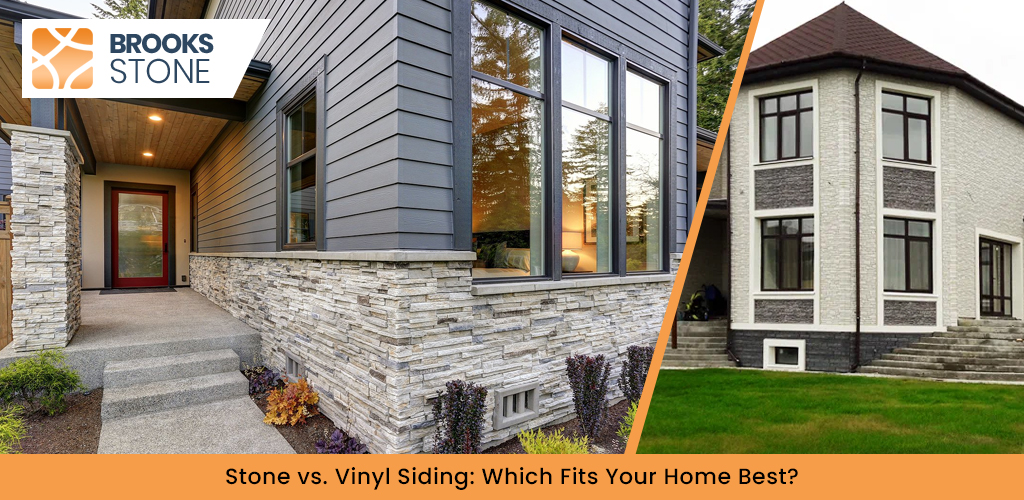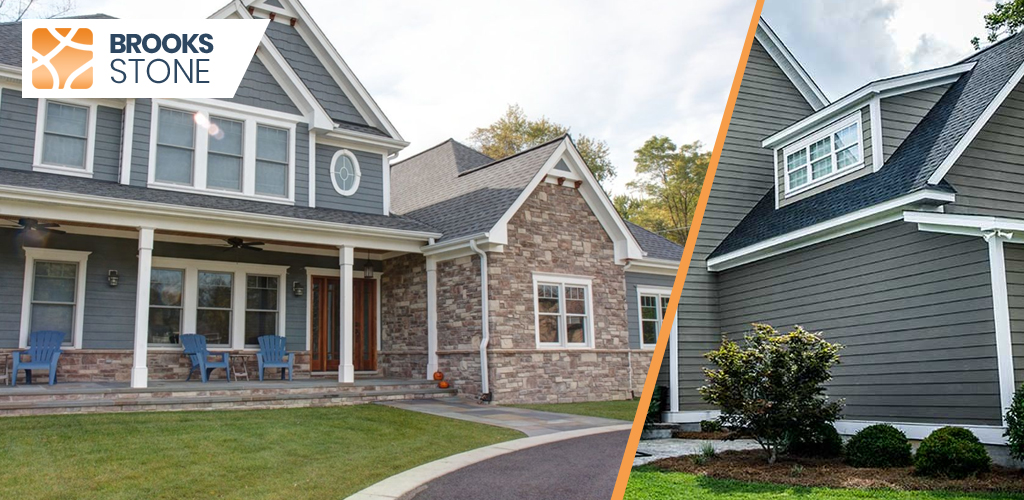Stone vs. Vinyl Siding: Which Fits Your Home Best?
Think about a cool new outfit for your house. This outfit protects it from rain, sun, and snow. We call this outfit “siding.” Two popular types of siding are stone and vinyl. They both make houses look nice, but they are very different. Choosing between them can be tricky. So, get ready to dive into the world of stone and vinyl siding.

What is Stone Siding?
Stone siding uses real or manufactured stones to cover the outside walls of a house. Real stone comes from the ground. People cut it into different shapes and sizes. Then, they attach it to the house. Manufactured stone looks like real stone. However, it is made from a mix of cement, sand, and other materials. People often call it “faux stone.” For example, it can look like granite or limestone.
First, stone siding is very strong and long-lasting. It can withstand harsh weather like strong winds and heavy rain. Additionally, it does not rot or get eaten by insects. Moreover, stone adds a beautiful, natural look to a house. It makes the house look grand and timeless. In addition, it increases the value of the house.
On the other hand, stone siding is quite heavy. It needs strong support from the house’s structure. Also, installing stone siding can be a complicated job. It often requires skilled workers. Therefore, this increases the cost of installation. Finally, fixing damaged stone can be difficult. It sometimes requires matching the existing stone.
What is Vinyl Siding?
Vinyl siding is made from plastic called polyvinyl chloride (PVC). Manufacturers mold it into long panels. These panels overlap each other when installed on a house. This creates a protective layer against the elements. For instance, it protects against rain and wind.
Firstly, vinyl siding is lightweight and easy to install. This makes it a more affordable option than stone. Furthermore, it comes in many different colors and styles. This allows homeowners to choose the perfect look for their house. Similarly, it is easy to clean with just soap and water. Also, it does not require painting.
However, vinyl siding is not as durable as stone. It can crack or dent from impacts. For example, a strong hailstorm can damage it. Additionally, extreme temperature changes can cause it to expand or contract. This can lead to warping or buckling. Finally, vinyl siding can fade over time from sun exposure. Consequently, it may need replacement sooner than stone.
Appearance and Style
Stone siding offers a natural, elegant, and timeless look. It gives a house a sense of permanence and grandeur. It comes in various textures, colors, and shapes. Thus, homeowners can create unique and beautiful designs. For instance, they can choose rough-cut fieldstone or smooth river rock.
On the other hand, vinyl siding provides a clean and modern look. It mimics the appearance of wood or other materials. It comes in a wide range of colors and styles. Therefore, homeowners can find something that matches their taste. For example, they can choose clapboard or shake styles.
Maintenance and Upkeep
Stone siding requires very little maintenance. It does not need painting or sealing. Occasionally, you might need to clean it with water to remove dirt or grime. Besides, it resists damage from insects and rot. For example, it is resistant to termites.
Conversely, vinyl siding is also low maintenance. It does not need painting. You can clean it with soap and water. However, you should inspect it regularly for cracks or damage. Furthermore, you should clean it to prevent mold and mildew growth.
Environmental Impact
Stone is a natural material. However, quarrying it can have environmental impacts. For example, it can disrupt natural habitats. Also, transporting heavy stone requires energy.
Vinyl is a manufactured product. The manufacturing process can release pollutants. However, vinyl siding is recyclable. This can reduce its environmental impact. Additionally, it helps insulate houses. This can reduce energy consumption.

Which is Right for You?
Choosing between stone and vinyl siding depends on your needs and preferences. If you want a durable, long-lasting, and natural-looking option, stone might be a good choice. However, it is more expensive.
If you want a more affordable, low-maintenance, and versatile option, vinyl might be a better fit. However, it is not as durable as stone. Finally, consider your budget, the style of your house, and your local climate.
